Here are some comments that Nelson shared way back when the Aleph-X amps were all the rage here (nearly 20 years ago...)
The 250's have greater current capacity, but twice the capacitance of the 240's and 244's. They will give a better bottom end, and will sound a bit different, for better or worse, depending on your situation and taste. There is very little practical difference between the 240's and 244's. Some have reported that the IRFP044 sounds a little "darker" (more narrow frequency bandwidth and greater high-frequency roll off) than the 240, though this is not really surprising as the 044 has greater capacitance than the 240 series. Essentially, greater capacitance provides slightly better bass, but at the cost of slightly reduced treble. The practical difference, though, is their current capacity. The maximum current and operating temperature ratings have lead many to use the IRFP240/244 for rail voltages of 20v or higher, while using the IRFP044 for 15-20v rails. The lower voltage versions of the amp tend to feature higher current, and the 044's can handle significantly more heat.
Device......Max Voltage...Max Current....Max Temp
IRFP044..........60v.............57A..............175c
IRFP240.........200v............20A...............150c
IRFP244.........250v............15A...............150c
Ian posted some of his impressions of using IRFP044 vs IRFP244s in his Aleph-X amps:
After using the IRFP044s, I then changed over one channel to the IRFP240's with the same power supply conditions (Grey's original schematic). Nelson's comments about gain devices effecting the sound were borne out here. In comparisons, the IRFP240 appears to have a somewhat thinner presentation and more brilliant high frequency response. The IRFP044 is richer sounding with more body in the midrange but otherwise less linear .....The jury is still out but I tend to think that while using only one pair per side of each, neither is better than the other and the IRF240 perhaps offers more latitude to use in various numbers for the right tonal balance. I doubt if I would use the IFRP044 for a tweeter amp in a bi amp setup and more likely the midrange.
The entire thread can be found here.
Good stuff. Thanks!
This old discussion might be of interest: Power Mosfet Choices
Nice link to a great discussion. Thanks.
In one of the manuals, Nelson remarks that people are always sending him 'better' caps but never better transistors. I took that to mean that the differences between transistors are, while real, not huge. Granted, there are relatively few manufacturers, too, as compared to caps or resistors.
I would be glad to send you some worse transistors to replace a selected few in your Aleph J or in your ACA. These will make it sound like hammered excrement. Then you will have an insightful time considering the proposition that worse transistors can exist but better transistors cannot.
That is one lesson I never needed to be taught, it was clear from the start that that is a universal truth! 🙂 Nelson knows what's better. No need to learn that twice! 

Maybe the lesson is that DIY’ers can do whatever they want, spend time on what they want, discussing things with cool creative and very, very intelligent people, based on but not limited to the products of others and our Idol, who himself encourages experimentation. And many times failing, but always learning something new along the way. Always taking responsibilty for him or herself, and able to share failures and achievements without being judged. For some, this is what keeps one going. Be your own judge.
To quote Papa regarding testing and evaluating output transistors:
«It is also a fine example of something a DIYer can do that a manufacturer will never do? I think so».
Sometimes this may produce fine results. The J Zen might be one such result, and I am going to try it. Why not.
To quote Papa regarding testing and evaluating output transistors:
«It is also a fine example of something a DIYer can do that a manufacturer will never do? I think so».
Sometimes this may produce fine results. The J Zen might be one such result, and I am going to try it. Why not.
The diyAudio Store is currently selling eight PCBs I designed, with four more coming in the next few months. I can't speak for anyone else, but I do know that the designs I've released to the diyAudio store, certainly do not include the "best" transistors & components I was aware of, on the date of release. Instead those designs have got the best overall trade-off (at least in my opinion) between
These trade-offs try to achieve "the greatest good for the greatest number" of Store customers: beginners and intermediates. The parts chosen aren't the absolute best, instead they are the perceived approximate best for a certain group of DIYers.
- can Denise DIY buy it at Mouser? Forget DigiKey, forget eBay, forget Farnell
- can Denise DIY buy it in a thru-hole package?
- Would Denise DIY pay a giant price premium for the best, compared to second- or third-best?
- Has Denise DIY seen this component before, in other DIY projects? Is it new and scary, or familiar and comfortable?
- Does the component offer huge margins of safety, in areas such as max-V, max-current, Safe Operating Area, etc?
- Is this component the lowest-noise possibility of them all? Even when it is used in a position/function where noise is not the primary concern?
- Does the best component require a heatsink, while the second-best and third-best options do not?
- Is the best component sole-sourced from a somewhat sketchy, 2nd or 3rd tier manufacturer? While the second- or third-best component is made by a world class, 1st tier manufacturer?
I really value those considerations, especially for people in countries like mine where sourcing from several different places is not only a logistic nightmare, but also a very important price consideration. Each different store brings additional charges when shipping internationally, if even possible.
I am just wondering: why "forget Digikey"? I was under the impression that Mouser and Digikey are, more or less, the same thing, although I have only ever bought at Mouser up to this point. Was is the driving force behind removing Digikey?
In my case, as long as all components can come from the same store, I'm OK with either, but I'm curious.
Thanks again,
Rafa.
I am just wondering: why "forget Digikey"? I was under the impression that Mouser and Digikey are, more or less, the same thing, although I have only ever bought at Mouser up to this point. Was is the driving force behind removing Digikey?
In my case, as long as all components can come from the same store, I'm OK with either, but I'm curious.
Thanks again,
Rafa.
I have been following Nelson Pass designs since the Audio Amateur days (A40). I never built the A40 because I could not obtain the output transistors. The Zen amplifiers looked interesting but had way too many capacitors in the signal path. I built the F5 from scratch out of curiosity. Man was I blown away , it made all my tube amps sound broken.
A trip to the Burning amp festival in 2017 and a Ampcamp semi kit had a huge impact on me. The output coupling cap had way less influence on the signal than it thought it would. All those years I thought capacitors were to be avoided like the plague. How could this little amp sound so good ?
6L6 ( Jim ) recommended the Aleph J to me , so I built it. Once again there were electrolytic capacitors in the signal path. And once again I loved the sound.
My M2X has an electrolytic capacitor in the signal path. I absolutely love this amp. And the icing on the cake was the Sony VFET amp. The active device weather it be a tube, a bipolar transistor , a JFET or a mosfet has a bigger influence on the sound signature than I thought. When it comes to Nelson Pass telling us anything about amplifier design I take it as absolute truth.
A trip to the Burning amp festival in 2017 and a Ampcamp semi kit had a huge impact on me. The output coupling cap had way less influence on the signal than it thought it would. All those years I thought capacitors were to be avoided like the plague. How could this little amp sound so good ?
6L6 ( Jim ) recommended the Aleph J to me , so I built it. Once again there were electrolytic capacitors in the signal path. And once again I loved the sound.
My M2X has an electrolytic capacitor in the signal path. I absolutely love this amp. And the icing on the cake was the Sony VFET amp. The active device weather it be a tube, a bipolar transistor , a JFET or a mosfet has a bigger influence on the sound signature than I thought. When it comes to Nelson Pass telling us anything about amplifier design I take it as absolute truth.
Those are all the AMPs I would like to have, but only have the new VFET version P. Are you referring to the new ones from the "lottery" or is this one of the "original" VFET amps? If the "lottery" one, I'm curious as to what you think of the Sony vs. the M2 and the AlephJ? I'm sure each has areas where it shines and some others in which they are outshined by their brothers, but I'd be interesting in your (subjective!) opinion....6L6 ( Jim ) recommended the Aleph J to me , so I built it. Once again there were electrolytic capacitors in the signal path. And once again I loved the sound.
My M2X has an electrolytic capacitor in the signal path. I absolutely love this amp. And the icing on the cake was the Sony VFET amp...
Thanks!
Rafa.
I was lucky enough to get the round 1 VFET P version. I like the Aleph J for the tube like warmth, to me the F5 is bright sounding ( I am sensitive to brightness). The M2X was the just right ( Goldilocks amp )until the VFET came along. There is just something about the VFET that just pushes all my buttons. I can't thank Nelson and all the Diy community enough. I love the build guides , thanks to Jim. The Diy store. The support provided is excellent. It is my hope that this hobby will continue for many generations. The attached picture is one channel of my version of the F5.
Attachments
Those ceramic insulators are perfect! Just about any thermal paste will work well, both sides of the ceramic wafers need to be coated. This should produce more uniform temps when mounted to the sinks and, as you've noted, temps are directly related to resistance, so this should even things out. If you are still having trouble after replacing the insulators, we'll explore other options.
I have a bunch of these 2mm thick ceramics that were given to me by my dear big brother. But, they are slightly smaller than the FET package (pictured). Thoughts on if I could safely get away with these.
The other issue is that using them will require taller brass M3 standoffs. The 2mm rise causes the DIP package to collide with the Amp board (pictured). Anyone have a digikey link to taller ones? Also the socketed M3 machine screws would need to be taller if I use split washers to lock out temperature creep... or I just leave the amp on forever....
Also I only have arctic silver heatsink compound on hand and its conductive. Hey if we don't get it on our CPU's... should be able to pull it off here right?
I broke down and ordered the Keratherm pads from diyaudiostore last night, but chose the cheapest shipping. I'll be an old man (older I guess) by the time they get here. If I can find everything on digikey.ca I can get it here in a couple days "cheap".
Attachments
Last edited:
Pass DIY Addict
Joined 2000
Paid Member
I’m thinking you will be fine with the slightly smaller ceramic insulator. You do need to use thermal paste for sure, though I’d be a little reluctant to use electrically conductive paste. The extra thickness sometimes necessitates longer standoffs for your PCB, though you might be able to get away without changing them. Just bend your mosfet legs so they are a bit longer before they tip up into the holes in the board. This will allow you to move the mosfet out from under the PCB. You may need to drill a new hole in the sink for this. If you do drill a new hole, be sure to deburr before mounting the mosfet.
On ebay, you can find a ton of 1mm thick aluminum oxide pads pretty inexpensively. These might be easier to use than 2mm thick ones. A variety of sizes are available.
On ebay, you can find a ton of 1mm thick aluminum oxide pads pretty inexpensively. These might be easier to use than 2mm thick ones. A variety of sizes are available.
Re-drilling not an option without a drill press, or set of taps, being the reason I splurged on pre-tapped heatsinks in the first place too.
1mm ceramic pads might work.
1mm ceramic pads might work.
pads are OK
goop necessary, proper one
longer bolts yeah, but you can add whatever to rise/lengthen standoffs - few washers, you can even cut some from plastic tube
goop necessary, proper one
longer bolts yeah, but you can add whatever to rise/lengthen standoffs - few washers, you can even cut some from plastic tube
Last edited:
- Home
- Amplifiers
- Pass Labs
- Aleph J illustrated build guide






